![[Graphics:HTMLFiles/index_1.gif]](../../../pkl/lola/Category Glue II/HTMLFiles/index_1.gif)
Rudolf Kaehr Dr.@
ThinkArt Lab Glasgow
Abstract
Part I:
A typology of different categories of glue (ordinary, super-, para-, proto-, trans-glue) are glued together with different strategies of gluing (set and category theory, combining logics, bi-category with (co)spans, polycontexturality and diamond theory). Interpretations of “interactional glue”, “nerve glue”, “logical glue” are sketched. Keywords of the dissemination of the concept of “glue” in history (Hegel, Marx, Lenin, Gunther, Derrida, Obama) and strategies (Glue, Opium, Mediation) of gluing them together under a general parapluie (ontology, society, solidarity, fear) are critically sketched.
The economical question is: Can we still afford to glue interactions together?
The category of glue isn’t blue. Categories are clueless to interaction and are banking unsecured resources.
Part II:
How to get rid of glue? From gluing to jumping. A new abstraction, the as-abstraction, and a subversion, the morpho-abstraction, has to be risked to avoid the complicity of category theory with the unavoidable exploitation of (conceptual) resources by the Western approach to interaction and communication in computer science.
To overcome the limitations of the category “glue”, contexturalization and mediation in a chiastic and diamond framework has to be elaborated and achieved to create chances to surpass and subvert such cultural and technological limitations.
![[Graphics:HTMLFiles/index_1.gif]](../../../pkl/lola/Category Glue II/HTMLFiles/index_1.gif)
![[Graphics:HTMLFiles/index_2.gif]](../../../pkl/lola/Category Glue II/HTMLFiles/index_2.gif)
"Whatever its nature (radio waves, wires, laser beams), the carrier is called a transmission line or wave. At the other end of this line the message is decoded and transcribed into information that has meaning for the person to whom it is addressed. But in order for the recipient to recognize and use the information, there must already have been information memorized that can be compared with the message just received. A final and important point is that disturbances occurring in the transmission line (the "noise") can alter the message and change its meaning.” (de Rosnay)
Joël de Rosnay, THE MACROSCOPE, A NEW WORLD SCIENTIFIC SYSTEM
http://pcp.vub.ac.be/macroscope/chap4.html
There is obviously a kind of a well known circularity involved with the buffer paradigm.
A sender is sending a message to a receiver, but this procedure is not working directly from sender to receiver, but indirectly via a buffer. Hence, the buffer is a receiver too, albeit a semi-receiver, but in its functionality to act as a buffer it has to receive the message which has to be buffered. Therefore, the buffer to work as a receiver needs a buffer, his own semi-buffer, which is enabling the main buffer to buffer the massage for a receiver. Again, this is only the beginning of an infinite regress. Our semi-buffer needs a semi-semi-buffer to semi-buffer the buffer to buffer the message for a receiver. And so on!
In other words: Super Glue isn’t enough. What is needed is the ultimate super glue, the super glue of the super glue.
Some Hello!
"Those links may make you pull your hair out! The "Glue" article is all over the place, but, I think, working around the problem you're addressing.” (John Powers)
The style of this “Glue"-text might succeed to reflect, “all over the place” (John Powers), the lack of strict and save interconnections between its heterogeneous parts. Also, as much is still glued together by the metaphor “glue”, the lack of continuity, deductive or explicative, is marking the gaps and the chances or challenges to choreograph jumps and salti to “bridge” together that what doesn’t belong together. What belongs together, and might be glued for ever, like mankind, nation, family, identity, doesn’t need to be bridged. It remains well placed and accessible in the labyrinth of the human cage.
especially:
![[Graphics:HTMLFiles/index_3.gif]](../../../pkl/lola/Category Glue II/HTMLFiles/index_3.gif)
"For instance, a configuration in which the messages from a sender component are sent
(to a receiver) through a bounded buffer defines the following diagram:
![[Graphics:HTMLFiles/index_4.gif]](../../../pkl/lola/Category Glue II/HTMLFiles/index_4.gif)
The node labelled cable is the representation of the set of bindings.” (Cat, p. 146)
http://www.cs.le.ac.uk/people/jfiadeiro/
![[Graphics:HTMLFiles/index_5.gif]](../../../pkl/lola/Category Glue II/HTMLFiles/index_5.gif)
![]()
![[Graphics:HTMLFiles/index_7.gif]](../../../pkl/lola/Category Glue II/HTMLFiles/index_7.gif)
Another strategy of streching and distributing glue is given by the general techniques of fibering and indexing categories. Where is the glue of fibered distribution, e.g. of agents in Multi-Agent Systems (MAS)?
Despite a great clarification of meta-glued fusions and confusions, meta-glue is still at work and necessary to enable interaction between distributed agents in the fibered polycontextural model of MAS. Fibered distribution is modeled in the framework of bundle categories along a general index fiber, i.e a “base manifold” (Pfalzgraf). The index fiber is gluing all those distributed free fibers together. Hence, fibered distribution is based on glue. This glue is gluing together all the fibers of stretched glue-fibres. The proposed technniques are higly sophisticated: the super glue is meta-gluing itself iinfinitely. That is, the base manifold or index set might be fibered itself. The constuction is “recursive, fractal and self-referential" (Pfalzgraf), hence bottom-less.
http://www.cosy.sbg.ac.at/~jpfalz/ACCAT-Tutorial-KI2004.html
"Actually, when listening to the experts speaking about polycontextural logics, he was reminded of the concept of fiber spaces.
This led him to the idea of introducing “logical fiberings” , i. e. taking the abstract concept of fiber bundles and combine it with logical spaces as fibers all put together over a base manifold (which acts as index set with a particular structure). Thus over each point of the base space there sits ('resides’ ) a fiber which can be interpreted as the local state space of that point ('agent’).
The fiberings method is found to be very useful in modeling communication and interaction between cooperating agents, due to the possibility to switch between a local/global point of view which is inherent to this framework."
Pfalzgraf et al, Towards a General Approach for Modeling Actions and Change in Cooperating Agents Scenarios, 1996
PFALZGRAF et al. Logic Jnl IGPL.1996; 4: 445-472 , http://jigpal.oxfordjournals.org/cgi/content/abstract/4/3/445
A more generalized approach to fibred logics is given recently by Pfalzgraf/Soboll as a “base diagram”, which is introduced with: “Fundamental important for our work is the observation that the general communication and cooperation structure of a MAS can be represented by a corresponding arrow diagram, called base diagram of the MAS.”
"To each MAS we associate such a base diagram, which represents the complete relational structure (i.e. communication in the general sense). The nodes of this arrow diagram represent agents, the arrows (and paths of arrows) hold the communication and cooperation information. This gives a category by its own right, more precisely a typed category.
In a MAS communication and cooperation (in general relations) between agents can change. This fact gives rise to the definition of the category MAS of all MAS where the objects are base diagrams of Multiagent Systems and the morphisms are MAS morphisms i.e. structure preserving maps between base diagrams.
Based on this category MAS a transformation system for Multiagent Systems can be established by applying the double pushout approach to Multiagent Systems.
[C]hecking the so called “gluing condition” solves this problem, in this paper we introduce an alternative algorithm.”
[cf. DPO: Double Push Out!]
Thomas Soboll, On the Construction of Transformation Steps in the Category of Multiagent Systems
http://www.portal.acm.org/citation.cfm?id=1428606
"The scenarios of cooperating robot agents were originally devised to demonstrate how the concept of a Logical Fibering can be used in a natural way to assign a system of Distributed Logics to a MAS, where every agent has an individual local logical state
space (fiber), the collection of all the fibers forms the global state space (fiber bundle) of the MAS.
This Fiber Bundle aspect can naturally be extended and generalized to introduce fibers of various structure types, modeling corresponding state space properties which are of relevance to model the complete state space of an agent, consisting of various modules (fibers) definig the complete type of an agent.” (Pfalzgraf, p.34)
Service-oriented approach
"Services add a social layer of abstraction over a component infrastructure in sense that they structure the process of interconnection (programmed interconnections).
- Services should be published at a level of abstraction that corresponds to a real-world activity or
recognisable business function (which is where social complexity can be understood)
- Systems should be socially-reflective.”
(Fiadeiro, 2008, p. 4)
Semantics of Service Discovery and Binding,
http://www-lipn.univ-paris13.fr/~choppy/IFIP/URBANA-CHAMPAIGN/URBANA-DATA/Fiadeiro-Urbana08.pdf
"For every activity a, a homomorphism B(a) of graphs between the body of B(a) and SF.
(This homomorphism makes configurations reflective.)" (ibd., p.9)
"Therefore, we decided to look for algebraic mechanisms of interconnection that can capture peer-to-peer interactions among autonomous components. That is why, in this paper, we report on the use of co-spans - pairs <fA,fB> where fA:A->S and fB:B->S are morphisms of a category D.” (Fiadeiro, CALCO'07, p. 195)
J. L. Fiadeiro, V. Schmitt (2007) Structured co-spans: an algebra of interaction protocols. In T. Mossakowski, U. Montanari, M. Haveraaen (eds) Algebra and Coalgebra in Computer Science. LNCS, vol 4624. Springer, Berlin Heidelberg, pp 194-208
Glue is gravitational, it holds things together by forcing them down.
Along the symbolic interaction metaphor of “I” and “Me” of a “Self”, a duplication of an agent into itself and his inner-environment might open up the possibility for a reflectional modeling. Such a reflectional distinction is reasonable only for a society of agents and is of no relevancy for a solipsistic concept of agents.
The inhaling concept of reflectional glue is highly solipsistic and is celebrating gluish hedonism.
Therefore, to stretch further the antropomorhic metaphor of “I” and “Me” of a “Self” for societal interaction, a new distinction has to be sketched: the distinction between the homogeneity of (empirically) different “Selfs"s and a heterogeneity between such “Selfs” and “Thou”. This move is quickly over-stretching ordinary glue. Between Herbert Mead’s Self as I and Me, and Gotthard Gunther’s Thou as a fundamentally different “I “ and “Me”, a chiasm demands challenging flexibility to any glue:
![]()
Such over-stretching is avoided by the denial of a dialogical difference between Self (or I) and Thou.
That is, the functionality of a buffer for sender and receiver could be incorporated from the outer-environment (channel) into the inner-environment of an agent as a reflectional part of the sender and receiver interaction. The inner-environment of an agent (Me) is taking the agent-specific elements of glue into its domain. Glue gets inhaled and with this incorporation it is loosing its procrastinating function as a non-computing coordinative buffer. Inhaled glue becomes part of the agent and its computational facilities.
This approach to reflectionality is leading strictly into meta-circular iterations and regresses. Quickly, the incorporated glue is starting to glue itself by incorporating its incorporated glue, endlessly.
A monocontextural modeling is drawing a strict distinction between the three identical, i.e. non-reflectional entities:
Sender, Buffer, Receiver with the activities: send, receive, put, get. That is, send-->put, receive<--get.
Therefore, there is no flexibility accessible to model reflectional incorporation of the functionality of buffers into the instances “sender” and “receiver".
A polycontextural modeling is drawing a distinction between two positions and their chiastic functionality as Sender and as Receiver. Hence, distinctions like “buffer as receiver” and “receiver as buffer” and also “buffer as sender” and “sender as buffer” are accessible.
Such a movement towards an internalization of the functionality of buffers is reducing the costs of interactions.
Because of its chiastic structure, such an internalization is also free of bad circularity, like the infinite regress of buffering buffers.
Hence, the simple distinction between active and passive processuality of an agent (computation) and buffer (coordination) has to be transformed into an active/passive activity of agents.
Glue-free mediation is still challenging the clue-less approaches of scientific modeling, formalization and implemention of interactivity and interactionality.
As sketched before, interactions mediated by buffers and their glue are interacting in the ontological-semiotic mode of is-abstractions (is-a, has-a) accepting basic presupositions of identity-driven conceptualization and implementation, i.e. ontology, semiotics and logic.
One of the main problems of modeling in the mode of the is-abstraction is the well known polysemy of semantics and its multiple inherence. Despite the amount of academic solutions, the problem remains as long as its identity presuposition, i.e. disambiguation, isn’t changed.
The sold solutions are based on direct or indirect ad-hoc principles and one-step-thinking.
The example below is base on the ingeneous procedure “rename” (Hendle). After renaming the term, the general ontology might be prolongated from the general ontology [Thing, Person] with its university-ontology to the furniture-ontology. With this procedure, no conflict will arise. At least as long as nobody starts thinking one step further.
![[Graphics:HTMLFiles/index_9.gif]](../../../pkl/lola/Category Glue II/HTMLFiles/index_9.gif)
Cost of disambiguation and buffering
Communication of disambiguated data is cost-free. But it is naive to think that it comes without costs. In contrary, the costs of disambiguation, necessary before any procedures can happen, are enormous. But disambiguation is arbitrarily stopped and is depending on a context. With a change of context, disambiguation has to start again.
Renaming is itself a kind of a buffering, i.e. gluing procedure, lacking any interactivity:
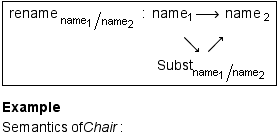

Some renamed and extended ontologies
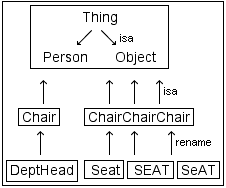
Extensions by renaming are ad-hoc and have to be repeated endlessly through the semantic universe, which is not restricted to the English language only. Even to stop its regress in concrete computing scenarios isn't cost-free. Fixed solutions, glued by chance, have to be re-fixed after the slightest context-change of the fixture. For complex, flexible and mobile computing, simply a disaster.
It is typical for the design of ontologies for semantic purposes in computation, like the Semantic Web, that the medium of its thematization, i.e. language, sign systems, is not mirrored in the General Ontology Language (GOL). GOL is designed in the framework of set theory which is mirroring Aristotelian ontology. There is no place for reflection, self-reflection and interaction between autonomous subjects left.
Reflectional approaches are much involved with the, at least, triadic-trichotomic semiotic in the sense of Peirce (Goguen).
Therefore, to the whatever Aristotelian ontology, at least the “ontology” of the vocabulary “Sign” has to be added for a conservative extension of the GOL. Hence, events or phenomena are occuring as Person, Object or Sign in an (semiotically) extended ontology.

Again:
“No self-reference is possible unless a system acquires a certain degree of freedom. But any system is only free insofar as it is capable of interpreting its environment and choose for the regulation of its own behavior between different interpretations.” Gunther, 1968, p. 44
Hence, glued, i.e. buffered, interaction is unnecessarily cost-intensive even before any computation and coordination can happen.
There are conceptual costs, too. The identity approach, even in a 2-categorical setting, is conceptually restricting possibilities.
A reflectional analysis of polysemy is an analysis of the semiotic actions of agents which are leading to the phenomenon of polysemy and its possible conflicts with other semiotic or logical principles. Therefore, such an analysis is more complex, because it has to describe the situation intrinsically, that is from the inside and not from the position of an external observer.
The aim of a polycontextural modeling of polysemy is to design the construction of polysemy in a finite and concrete manner.
The distinction of two fundamnetally different kinds of abstractions, the is-abstraction (identification) and the as-abstraction (thematization), might help to model the reflectional situation. The formula of the as-abstraction “asa” is: “X as Y is Z”, hence, the is-abstraction “isa”, X is X, can be read as an abbreviation of: “X as X is X".
The as-abstraction is introducing highest flexibility for modeling, designing and implementing complex reflectional situations. The as-abstraction is abstrating from the main principle of any computation and computing: the principle of identity.
![[Graphics:HTMLFiles/index_14.gif]](../../../pkl/lola/Category Glue II/HTMLFiles/index_14.gif)
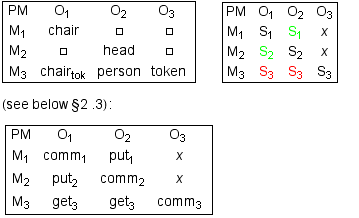
Mono-contextural "isa":
S1: Chair is part of a furniture ontology (Object),
S2: Chair is part of a department ontology (Person),
S3: Chair is part of a vocabulary ontology (Vocabulary).
Poly-contextural "isa as":
O1S1: Chair as such, that is, as an object (furniture) "Chair”, Chairobj,
O2S2: Chair as such, that is, as a person (head) "Chair”, Chairpers,
O3S3: Chair as such, that is, as the token (vocabulary) "Chair”, Chairtoken.
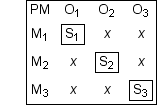
Here, "as such" means, that the ontologies Object, Person and Vocabulary can be studied and developed for their own, independent of their interactivity to one another but placed and mediated in the constellation of their poly-contexturality, that is, their distribution over the 3 loci, O![]() O
O![]() O3.
O3.
Voc O3S3 in Furn O1S3 :
The token "Chair" as used to denote the object "Chair”, Chair![]()
VocO3S3 in Dept O2S3 :
The token "Chair" as used to denote the person "Chair”, Chair![]()
Chair O2S2 in Dept O1S2 :
The object Chair as used in the person ontology Dept, Chair![]()
Chair O1S1 in Furn O2S1 :
The person Chair as used in the object ontology Furn, Chair![]()
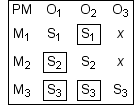
Reflectional situations
Chair O2S2 in Dept O1S2:
System O1S1 has in its own domain space for a mirroring of O2S2. This space for placing the mirroring of O2S2 is the reflectional capacity realized by the architectonic differentiation of system O1. In other words, O1 is able to realize the distinction between its own data and the data received by an interacting agent. Data are therefore differentiated by their source, e.g. their functionality, and not only by their content.

Chair O1S1, in Furn O2S1:
System O2S1 has in its own domain space for a mirroring of O1S1.

A (re)solution of the problem
The department Dept for itself has no conflict with polysemy. This conflict between Dept and Furn is mediated by the Voc. That is, the Person of the Dept as Chair is a person and nothing else.
The furniture Furn for itself has no conflict with polysemy. This conflict between Furn and Dept is mediated by the Voc. That is, the Chairs as objects of the Furn are chairs and nothing else.
The vocabulary Voc for itself, containing “Chair”, has no conflict with the polysemy between Dept “Chair” and Furn “Chair".
The meaning of the polysemic situation is realised by
Meaning of (O3S3) = interaction of (O1S3, O2S3)

![]()
The conditions for a conflict arises excactly between
O1 (S1,2,3) and O2 (S1,2,3) mediated by O3S3 as visualized by the blue triangles.

Both Furn and Dept are using Voc and both are using the string Chair of Voc. Both are different and are mapping the Voc differently relative to their position, thus the Voc has to be distributed over different places according to its use or functionality. The Voc used by Furn is in another functionality than the Voc used by Dept.
Up to now we have not yet produced a contradiction but only a description of the situation of polysemy, that is, the necessary conditions for a possible ontological, semantic and logical contradiction.
A user-oriented approach to the modelling of polysemy has to ask "For whom is there a conflict?” Therefore, we have additionally to the semantic and syntactic modelling of the situation to introduce some pragmatic instances. In our example this could be the user of a Query which is answering in a contradictory manner.
Query´s contradictory answer
Now we have to deal with the contextures: (Query, Voc, Furn, Dept).
In the classic situation, the Query answers with a logical conjunction of Chair as Person and Chair as a Department member, which both are logico-semantically excluding each other and therefore producing for the user of the Query a conflicting or contradictory answer if put into a single logical conjunction.
Logic comes into the play also for the polycontextural modelling, but here conjunctions too, are distributed over different contextures. And therefore, a contradiction occurs only if we map the complex situation all together onto a single contexture.
(O4M4) = Query
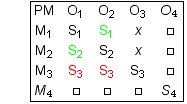
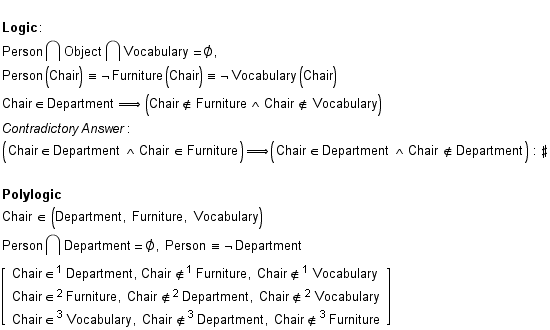
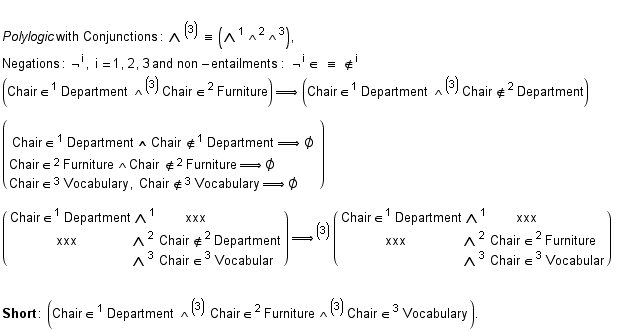
If we give up all the introduced ontological distinctions of polycontexturality and reducing therefore our ontologies to a single mono-contextural general ontology we saved our famous contradiction again. But now, this contradiction is a product of a well established mechanism of reduction. And sometimes it isn’t wrong to have it at our disposition.
The costs of the polycontextural approach lies in its novelty and its intrinsic complexity.
Observations about observations in another worldmodel
"Unlike observation of the first order, which sees all elements in the world as connected in one context with geometric symmetry, observation of the second order views a world that is poly-contextual (polykontextural). In the poly-contextual world, the values of social institutions may not all be in the same context.From such perspective, labeling two values in different contexts as a set of binary for comparison in the same matrix is deemed to generate inaccurate analysis.
This is why “many-valued-logic” (mehrwertige Logik) is so essential in the poly-contextual world.When the values in seemingly antithetical binaries are, in fact, of different contexts, for those values to be antithetical yet mutually complementary is no longer impossible. In fact, this antithetical yet complementary pattern that is unthinkable in the realm of the world of the observation of the first order is totally consistent with the many-valued-logic of poly-contextual settings.
According to Lin, this many-valued-logic is exactly the essence of traditional Chinese law and its legal system."
Review: Duan Lin. _Weibo Lun Zhongguo Chuantong Falu_(Weber's Analysis on Chinese Traditional Law: Critiques on Weber's Comparative Sociology)
Dr. Lin Duan has provided a profound study on the demerits of Weber’s methodology. See Lin Duan, Rujia lunli yu falü wenhua: shehuixue guandian de tansuo (Confucian Ethics and Legal Culture: Exploration from Sociology), Beijing: Zhongguo zhengfa daxue, 2002, p. 93; 122.
Diamond constructions are reducing the costs of interactivity by the fact that their operations are intrinsically interactive. That is, the interplay of the conditions of matching and the compositions themselves are reflected in the complementarity of categories and saltatories of diamonds.
Diamonds are offering more structural space to model and implement interactivity than categories and n-categories.
The general strategy to reduce the costs of interaction is to find a concept and apparatus that is offering a wider logical scope to model the dynamics of the differences between actors and their communication.
The other part of the strategy is to separate basic functions, like coordination/computation (Fiadeiro) or locality/connectivity (Milner). Both strategies are changing the priority of time in computing to the favor of space, “metaphorical space” (Milner) for the localization of separated aspects of (mobile) computation.
This enlargement of “metaphorical space” happens for computer science in different steps, all trying to capitalize on new and broader concepts from other disciplines or on developing own computer science specific concepts, like , e.g. Goguen’s Institutions and Padawitz’ Swinging Types.
Modal logics
Coalgebra
Category theory
Combining logics
n-Category theory
But there are some fundamental limitations occurring in this endeavour.
"Grammatologically, the Western notational system is not offering space in itself to place sameness and otherness necessary to realize interaction/ality. Alphabetism is not prepared to challenge the dynamics of interaction directly. The Chinese writing system in its scriptural structuration, is able to place complex differences into itself, necessary for the development and design of formal systems and programming languages of interaction. The challenge of interactionality to Western thinking, modeling and design interactivity has to be confronted with the decline of the scientific power of alpha-numeric notational systems as media of living in a complex world. “ (Interactivity, 2008)
To overcome such limitations, the graphematic and trans-classical strategies of:
Polycontexturality,
Morpho- and Kenogrammatics,
Proemiality and Chiasm,
Diamond theory,
had been introduced as subversive and experimental interventions and realized in form of fragmentarism.
It seems that for each step there is a progressive extension of the possibilities of ‘space-ing’ interactionality and reflectionality of notational systems.
All known strategies have their own advantages and deficits. The main problems are not so much the limitations of the specific approaches but their applications to domains for which they are not specifically designed and are therefore inadequate albeit the compagning propaganda.
It surely would be an absurd misunderstanding, also quite typical for the ‘quick-reading’ ritual of censors, to believe that I am hallucinating a computer science based on Ancient Chinese hieroglyphs. (Kaehr, The Chinese Challenge).
"Category Theory is advocated as a good mathematical structure for this integration precisely because it focuses on relationships and interactions! The focus that Category Theory puts on morphisms, as structure preserving mappings, is paramount for Software Architectures because it is the morphisms that determine the nature of the interconnections that can be established between objects (system components)." (Fiadeiro, 2002, p. 12)
Category oriented implementations are based on the concept of categorical composition of morphisms which in itself is neither interactive nor reflective. It is mentioned that morphisms are representing interactions and interconnections. This might be appropriate for non-reflectional interactions, like actions on objects (Bunge). Reflection, and especially social reflection, gets into conceptual trouble. Interaction might be represented by morphisms, but reflection would then be represented by ‘morphisms of morphisms’.
This figure leads automatically to the question: Is a morphism of a morphism, i.e. a second-order morphism (cf. Fiadeiro’s homomorphism!) conceptually a morphism or something else? If it is conceived as a morphism, we are back again to the first-order concept of morphisms, i.e. to morphisms without reflection. And hence, the second-order concept can be reduced to a first-order concept. Otherwise, if the construct of a morphism of a morphism isn‘t reducible to a first-order categorical concept, then it is violating the axioms of the framework of category theory, especially its axiom of identity.
Hence, the workspace of the categorical interpretation of interactivity is modeled by the metaphors of super glue, for categories, and of stretched glue, for n-categories.
Such societal and reflectional metaphors are reasonable for computer science only if they are explicitly declared as weak metaphors, not suitable for social and psychological adaption. Albeit the fact that interdisciplinary confusions are supporting academic marketing strategies, they are nevertheless boring and economically and politically dangerous.
The dissemination of categorical systems in the sense of polycontexturality is offering the possibility of interactionality and reflectionality. But still for a considerable price of interpretative, i.e. observer depending, delays. Interactivity between disseminated contextural systems is guided by the strategies and mechanism of proemiality and are realized as chiasm.
Each contexture of a contextural compound constellation is composed by sub-contextures, usually as elementary morphisms and is of trichotomic structure. Thus, polycontexturality is a dissemination of trichotomic structures, that are, in themselves, not prepared to reflect their interactionality. Interactionality and reflectionality are introduced polycontexturally as interactions between different contextures, i.e. as trans-contextural events.
From an observer theoretical point of view, chiasms between contextures, realizing interactivity, is observed from an external observer. Hence, their internal mechanism is still not yet glue-free, but involved in a kind of a dissolution of the adhesion of glue, i.e. the chiastic jump between disseminated contextures is still sniffing glue and sticking the elements of mediation together by some metaphysical or kenomic glue.
Chiastic glue is technically delivered mainly by the coincidence relations of chiasms. They are responsible for guaranteeing that the distributed order relations, which are themselves glued by definition (matching conditions), and their risky exchange relations interact in harmony with similitude. The fulfillment of the coincidence relations in a chiasm is establishing categorial similarity, i.e. family resemblance of categorial kind. Otherwise, chiastic glue would be over-stretched and loosing its ends.
In other words, for chiasms to work, their relationality has to be in categorial harmony of similitude. Chiastic concepts have to fit together by general mappings or morphisms. Chiastic jumps, possible in chiasms, are insured by harmony and traced back and ruled by the coincidence or similarity relations. This important restriction and complicity to similarity is necessary for chiasms to avoid empty statements, like “everything is connected”, of universal connectionism. It also prevents jumps into the void.
Super-glue and stretched super-glue interactions, realized as buffers and buffered systems, don’t need observers. They are designed and conceived as observer-independent objective utilities and mechanisms.
Therefore, the observer-independent approaches might be adequate for signal and information processing (information interaction) but are missing the demands for interactional situations of semantic and knowledge modeling and computation (symbolic interaction).
Jumps without guaranteed security have to be realized by somersaults, i.e. by salti. Salti are in a strict discontextural opposition to glued connections and secured journeys involving jumps. Hence, their theoretical modeling happens with the saltisitions of saltatories. Saltatories are building together with categories diamonds. What has to be risked is to stage-manage the drama of glue-free interactions and reflections within the framework of diamond theory. But metaphors like “stage” and “framework” are misleading by their unbroken coherence.
Categories: duality
Chiasms: guided complementarity or family resemblance (Wittgenstein)
Diamonds: discontecxtural complementarity
The epistemic tendencies “computation” and “coordination" (Fiadeiro) are thematized by the diamond strategies as complementary, antidromic and parallax.
Diamonds are offering a new kind of a “metaphoric space” to distribute both tendencies while keeping their autonomy untouched. With such a heterarchic order between computation and cordination there is no need to suppress the computational aspects of coordination and the coordinational aspects of commputation.
This is in contrast to the n-categorical modeling where there is no concept and no mechanism available on a principle level to implement the antagonistic epistemical directions of computation and coordination. Furthermore, both are set by the categorical approach into a hierarchical order: first computation, then coordination or the other way round: first coordination, then computation. Both are strictly excluding “social life”, i.e. interaction between computation and coordination.
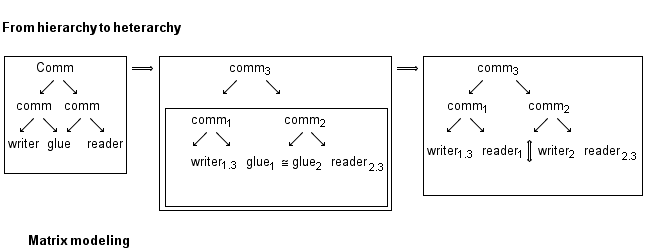
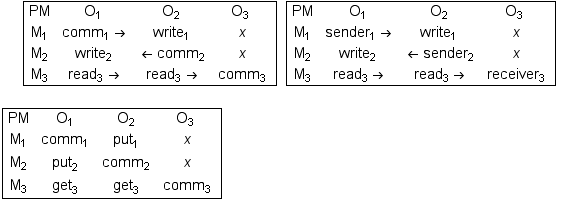

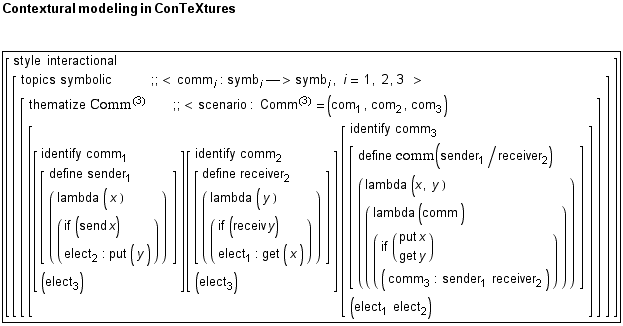
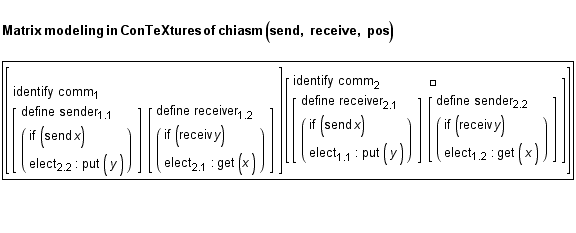
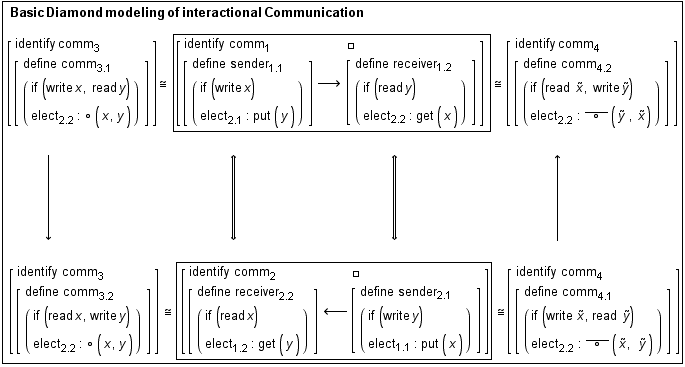
![]()
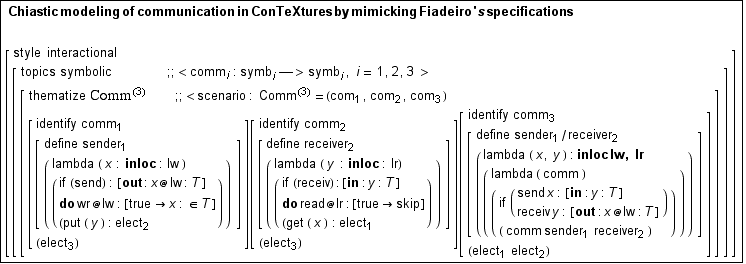
There are many ways to measure costs, efficiency and resources of computational interaction and communication.
One quite direct way might be to show the parallel, or heterarchical structure of diamond modeling and implementation in contrast to hierarchical understanding of interaction and communication. With the presumption that “parallel” processing is more cost-efficient than non-parallel computing. And obviously, it has to be shown that polycontextural and diamond computation is at least conceptually “parallel".
Hence, using glue to organize hierarchically interaction, or even: the ‘social life’ of computing is, from the very beginning, more expensive and less efficient than heterarchical polycontextural and diamond computing.
Such considerations about efficiency and cost can be analyzed in detail for specific constellation.
Structual costs of deepness and broadness of a formula are not to be confused with the well-known complexity analyses based on computional time of big Omikron: O(n).
An analysis of the system structures of glued interaction and of chiastic and diamond interaction can be put into the simple results:
The kernel of glue-modeling consist of 3 unique instances (ports) at 1 locus (or nil), e.g. Comm = (sender0, glue0, receiver0).
The kernel of chiastic modeling consist of 2 unique instances (roles) at 3 loci, e.g. Comm![]() senderi, receiveri), i=1,2,3.
senderi, receiveri), i=1,2,3.
The kernel of diamond modeling consist of 2 unique instances (roles) at 4 loci, e.g. DiamComm![]() senderi, receiver
senderi, receiver![]() , i=1,2,3,4.
, i=1,2,3,4.
The main difference between glued and mediated communication, i.e. between “Comm = (sender0, glue0, receiver0)" and “Comm![]() senderi, receiveri), i=1,2,3” and its mediation operation, is the fact that “glue0” is a (coordinative) instance (object) for “(sender0, receiver0)" while “mediation” is a (computational) pocess (action) between the positions pos
senderi, receiveri), i=1,2,3” and its mediation operation, is the fact that “glue0” is a (coordinative) instance (object) for “(sender0, receiver0)" while “mediation” is a (computational) pocess (action) between the positions pos![]() “senderi, receiveri”.
“senderi, receiveri”.
Structural Costs
cost(X) = (n, m)
n: deepeness
m: broadness
cost(glue) = (3, 1),
cost(chiasm) = (2, 3),
cost(diamond) = (2, 4)
In other terms, deepnes is representing computational complexity and broadness corresponds to the degree of polycontextural coordination and organization of disseminated computations.
Concept and Kantarovic tree analyses for polycontextural constellations (formulas, etc.) can serve as a measure for structural complexity by the degree of deepness and broadness of the fundamental constructs of a situation. Broadness is the measure of the degree of dissemination, deepness is the conventional measure of the complexity of a formula. Because of their monocontextiurality, broadness is set to 1 for all classical formalizations.
Speed vs. directness
Speed of computation is crucial for closed non-interactional computational systems, i.e. for algorithmic computation. For interactional systems directness of reaction to change of the system/environment relationship are crucial. It is clueless to finish in high speed a calculation which has become obsolete in its premises because the situation has changed. The measure for interactional systems is directness of response and not speed of calculation. From the point-view of the calculation paradigm, higher directness appears as higher speed. But that’s misleading. Directness means less steps to calculate and not higher speed.
Optimization for interactional computing systems means optimizing the architectural organization to support directness.
Speed for algorithmic systems is connected with computational time, i.e. with temporalization. Directness of interactional systems is connected with organizational space, i.e. with architectonics and topology. Organization (coordination) and computation are complementary as are directness and speed.
hierarchic chiastic heterarchic modeling

Optimization for interactional computing systems means optimizing the architectural organization to support directness.
Speed for algorithmic systems is connected with computational time, i.e. with temporalization. Directness of interactional systems is connected with organizational space, i.e. with architectonics and topology. Organization (coordination) and computation are complementary as are directness and speed.